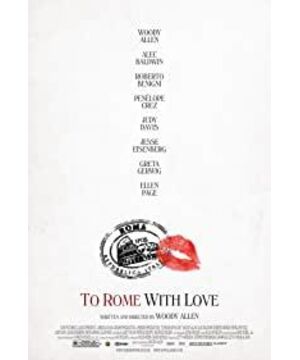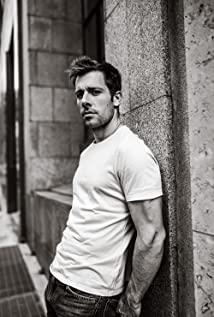Woody Allen's third absurd comedy depicting famous European cities after "Midnight in Paris" and "Midnight in Barcelona". Woody is over fifty years old, and he produces new works almost every year. At the same time, the quality is stable and his personal style is outstanding. In the early days, "Anne Hall" was a typical representative, and won four Academy Awards for Best Director, Best Picture, Best Actress, Best Screenplay, and four awards from the British Academy of Film and Television Arts in that year. The latter stage, represented by "Midnight in Paris" and "Blue Jasmine", was nominated for Oscar for Best Original Screenplay and Best Director. When it comes to Woody Allen, you can probably think of labels such as "talkative", "comedy", and "intellectual", and the themes often revolve around "death", "love", and "immoral behavior" Discuss, involving different social psychology, literature, politics, philosophy and other ideologies of various classes, and often non-typed films that use formalist narrative as the main narrative method. Compared with the literature and art of "Midnight in Paris" and the classic social psychological ideology of "Blue Jasmine", "Love in Rome" seems to have no obvious ideology, but the absurd comedy style of its logo is unique here, with a highly innovative formal structure. brought unexpected results. We know that the viewer's hunch about the form in the film comes from: the information in the work and previous experience - daily life and previous artistic experience. For example: give you a string of numbers 1, 2, 3, through our understanding of the order of natural numbers, we will think that 4 appears next. The ability to discern information, observe formal structure and generate psychological expectations can be generated through real-life experience and knowledge of formal conventions in past viewings. For example: in the classic thriller "The Shining", the famous director Kubrick arranges the kitchen knife above Danny in the hotel kitchen scene, as a hint of danger, so that we can expect the climax to come. So, in "Love in Rome", the famous American architect John Foy met Jack in the alley and street, and he was a guest at Jack's house, and he met Jack's girlfriend. The story of the pair with Jack, unexpectedly, the direction of the story has undergone a great change, but in the end it tells about a romantic love between Jack and his girlfriend's friend Monica (a romantic derailment bla). bla). This highly innovative formal structure may at first be seen as strange and alien, because it does not conform to conventional forms (such as Van Gogh's paintings, which are difficult to appreciate at first, and then have their own set of unconventional form structure). This new formal structure is very interesting, its significance lies in that it can bring new recognition and new experience to the viewer, and the new formal structure may also become a classic or a convention, thus forming a new expectation. Routines in movies sometimes don't follow routines in real life, it can be separated from real life, and the absurd comes from it. In "Love in Rome", Mr. Santoli is a very gifted tenor. He was discovered when he was singing in the bathroom, but he could not perform well on the stage. Finally, the mobile bathroom was put on the stage. Santoli sang while washing in the bathroom, and the performance was a great success (it is said that this plot is similar to Zhang Yang's "Bath"). We found this to be quite unusual based on real-life experience. In other words: "Real-life experience has no bearing on this work". This requires viewers to put aside their daily living habits and accept the unique conventions of each work when stylized film art. Woody Allen uses highly innovative routines to let us see: unusual things happen. Through the continuous emergence of new forms and conventions, we find that for works of art, in terms of experience, artistic experience seems to be more important than life experience. Routines in movies sometimes don't follow routines in real life, it can be separated from real life, and the absurd comes from it. In "Love in Rome", Mr. Santoli is a very gifted tenor. He was discovered when he was singing in the bathroom, but he could not perform well on the stage. Finally, the mobile bathroom was put on the stage. Santoli sang while washing in the bathroom, and the performance was a great success (it is said that this plot is similar to Zhang Yang's "Bath"). We found this to be quite unusual based on real-life experience. In other words: "Real-life experience has no bearing on this work". This requires viewers to put aside their daily living habits and accept the unique conventions of each work when stylized film art. Woody Allen uses highly innovative routines to let us see: unusual things happen. Through the continuous emergence of new forms and conventions, we find that for works of art, in terms of experience, artistic experience seems to be more important than life experience. Routines in movies sometimes don't follow routines in real life, it can be separated from real life, and the absurd comes from it. In "Love in Rome", Mr. Santoli is a very gifted tenor. He was discovered when he was singing in the bathroom, but he could not perform well on the stage. Finally, the mobile bathroom was put on the stage. Santoli sang while washing in the bathroom, and the performance was a great success (it is said that this plot is similar to Zhang Yang's "Bath"). We found this to be quite unusual based on real-life experience. In other words: "Real-life experience has no bearing on this work". This requires viewers to put aside their daily living habits and accept the unique conventions of each work when stylized film art. Woody Allen uses highly innovative routines to let us see: unusual things happen. Through the continuous emergence of new forms and conventions, we find that for works of art, in terms of experience, artistic experience seems to be more important than life experience.
View more about To Rome with Love reviews











